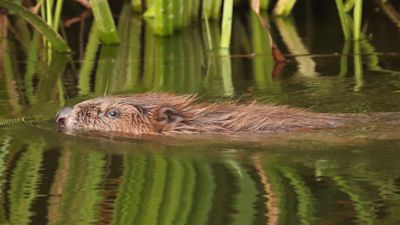Beavers in Devon key to reducing flooding and drought, say scientists

Scientists have found the reintroduction of beavers to Devon is helping to reduce the impacts of flooding and drought.
The University of Exeter and Devon Wildlife Trust have worked with land owners to monitor four wild beaver territories over the past ten years.
Dams built by the beavers are now storing more than 24 million litres of water, that is the equivalent to around 10 Olympic-sized swimming pools of water.
Having been hunted to extinction 400 years ago, beavers returned to the River Otter in 2014.
No one knows how or by whom the animals were reintroduced, but in 2020 the beavers were given the legal right to stay. There are now 20 separate family territories along the river and its tributaries.
In what was once a shallow brook there is now one of the first wetland created by beavers in the UK for centuries. They’ve built a bank capable of holding back a huge quantity of water.
Sam Bridgewater is from Clinton Devon Estates, where one of the wetlands has been created. He said: “If I’d asked someone from the conservation team to create me a wonderful wildlife pond it would have been difficult.
"Beavers have done this for free and we’ve got some amazing orchids around here, it’s looking great. There are wading birds and dragonflies about so we are very happy from the conservation perspective.”
By combining drone imagery with water depth monitoring, the researchers were able to examine the wetlands created by beavers in four separate family territories.
The results show that together the wetlands were storing more than 24 million litres of water, with an average of 6 million litres stored per site.
Dr Holly Barclay from Devon Wildlife Trust said: “One of the incredible things about working with beavers is seeing their amazing eco system engineering capabilities and how they are able to transform the landscape around them to suit what they want.
"In this area, the water is shallow in the brook, so they have built a series of dams to create deeper water where they can live and feed.”
One of the wetlands is close to homes that were prone to flooding but the research has shown the dams are slowing down the water, and in dry spells helping to keep up the water table higher so the fields are less likely to dry out.
Farmers are also receiving some financial support to give up parts of their land to beavers.
Dr Holly Barclay added: “There are challenges for land owners when you have the formation of a beaver wetland leading to the loss of land, so our challenge and what we are working towards at the moment is how to harness funding and other incentives to make this space available.”